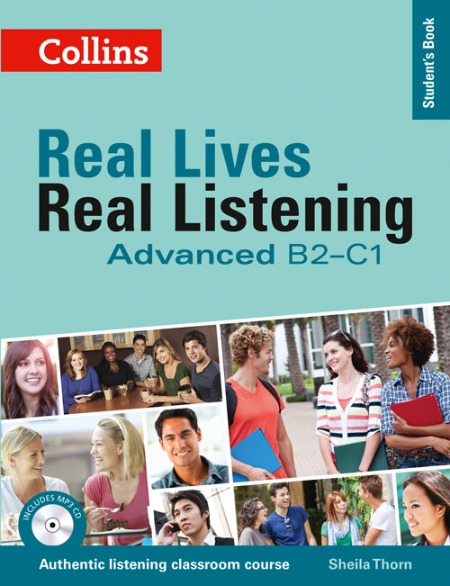A book I've used - Real Lives, Real Listening
Real Lives, Real Listening
(Advanced B2–C1)
Sheila Thorn
HarperCollins 2013
 When I first saw this book, my immediate reaction was: ‘I wish I had had it when I was learning English myself!’ The textbooks that we had in my English classes all used artificially generated dialogues, which hardly resembled real-life talk, not only in terms of grammatical structures and vocabulary, but also in terms of pronunciation. No wonder I struggled quite a bit understanding people during my first couple of months in the US!
When I first saw this book, my immediate reaction was: ‘I wish I had had it when I was learning English myself!’ The textbooks that we had in my English classes all used artificially generated dialogues, which hardly resembled real-life talk, not only in terms of grammatical structures and vocabulary, but also in terms of pronunciation. No wonder I struggled quite a bit understanding people during my first couple of months in the US!
Real Lives, Real Listening (Elementary (A), Intermediate (B1–B2), and Advanced (B2–C1) provides teaching material based on authentic listening texts. What I mean by authentic is unscripted dialogues, with their numerous features of spoken language, including idiomatic expressions, hesitations, false starts and assimilations.
The dialogues here are real-life spoken conversations, providing ‘ear-training’ and preparation for successful interaction in real-world contexts. If you teach in a context where English is not the dominant language, they will help bring a piece of the ‘world out there’ into your classroom.
The interviews are with people from different parts of the world in varieties of English, not just the usual North American or British English. In their academic and professional life, many of our students are likely to interact with both native and nonnative speakers, so being exposed to a range of pronunciation styles and accents in the classroom is definitely an advantage. Here there is a good balance. It also gets across the message that accents are OK. I know from my own teaching experience that some students worry too much about how ‘native’ they sound. In fact, I myself was self-conscious about my accent for quite a long time, until I realised that being proficient in a second language doesn’t necessarily mean acquiring ‘native-like’ pronunciation. By including conversations with intelligent and competent non-native speakers of English, the idea of language diversity is promoted
The book has a coherent and easy-to-follow structure. It’s divided into three main sections: My Family, A Typical Day, and A Place I Know Well, with five units in each section. The aim of the first three units is to help students acquire certain grammatical structures and lexical items, whereas the other two are geared towards recycling this knowledge. Each unit also has a verbatim transcript of the dialogues.
The exercises in each unit provide teachers with a whole variety of activities. Pre-Listening Comprehension activities aim at preparing learners for the listening text through discussions or building-schema tasks. Listening Comprehension activities come in various formats, such as gap-fill, true/false and questions, to guide students’ understanding. The Interesting Language Points exercises are probably my favourite. They present language features that make the speech of the interviewee in the target dialogue different from other dialogues in the book, but used by many speakers in real-life spoken interaction. For example, one activity addresses unique characteristics of an east London accent, another one explains how people use negative statements with a positive meaning, yet another one compares different lexica items that have the same meaning in American English and British English. So not only do these exercises help with a better understanding of the dialogues, they also raise learners’ awareness of the richness and complexity of English use.
What I also liked is the emphasis on vocabulary. At the end of each unit is a list of words and phrases used as well as a section of exercises focusing primarily on lexical items found in the listening text. The format of these exercises allows learners to work independently, which is true for many other tasks included in the book. Alternatively, the teacher can use them as homework assignments.
But the real plus of this material is that it features real people – with their lives, experiences and opinions. I believe it helps students expand their horizons, learn more about the world and see English as a resource for a variety of opportunities in this life: academic, professional, cultural and social.
Elena Shvidko is a PhD student and a composition instructor in the Department of English at Purdue University, USA. She has taught ESL in academic and community contexts.
Comments
Write a Comment
Comment Submitted